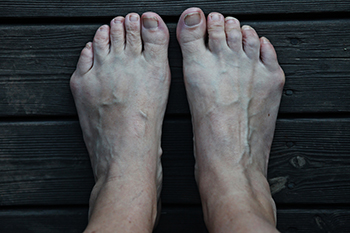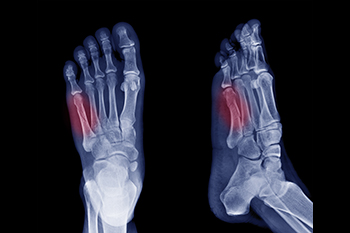Connect With Us
Blog
Items filtered by date: February 2025
Minimally Invasive Bunionette Surgery

A bunionette, or tailor’s bunion, is a bony prominence on the outer side of the foot at the base of the fifth toe. It develops due to pressure, improper footwear, genetics, or structural foot abnormalities. This condition often affects individuals who wear narrow or tight shoes, such as high heels, or those with naturally wide feet. Conservative treatments, including wider footwear, padding, orthotics, and anti-inflammatory medications, can help reduce discomfort. However, if pain persists despite these measures, minimally invasive bunionette surgery may be an option. This procedure involves tiny incisions and specialized instruments to realign the bone, removing pressure on the affected joint with minimal tissue disruption. Recovery is typically faster than traditional surgery, with reduced swelling and pain. If a bunionette is interfering with your daily activities, it is suggested that you consult a podiatrist to determine if minimally invasive surgery is the right solution for you.
Foot surgery is sometimes necessary to treat a foot ailment. To learn more, contact David Cain, DPM of Iowa. Our doctor will assist you with all of your foot and ankle needs.
When Is Surgery Necessary?
Foot and ankle surgery is generally reserved for cases in which less invasive, conservative procedures have failed to alleviate the problem. Some of the cases in which surgery may be necessary include:
- Removing foot deformities like bunions and bone spurs
- Severe arthritis that has caused bone issues
- Cosmetic reconstruction
What Types of Surgery Are There?
The type of surgery you receive will depend on the nature of the problem you have. Some of the possible surgeries include:
- Bunionectomy for painful bunions
- Surgical fusion for realignment of bones
- Neuropathy decompression surgery to treat nerve damage
Benefits of Surgery
Although surgery is usually a last resort, it can provide more complete pain relief compared to non-surgical methods and may allow you to finally resume full activity.
Surgical techniques have also become increasingly sophisticated. Techniques like endoscopic surgery allow for smaller incisions and faster recovery times.
If you have any questions please feel free to contact our office located in Ames, Iowa . We offer the newest diagnostic and treatment technologies for all your foot and ankle needs.
Heel Pain in the Morning?
Proper Running Foot Strike

The proper running foot strike is essential for preventing injuries and improving performance. While running, the anatomy of the foot plays a key role in how the body absorbs impact. There are several types of foot strikes, each affecting the body differently. A heel strike occurs when the heel hits the ground first, often seen in runners with a longer stride or those who overstride. A midfoot strike is when the middle of the foot lands first, offering a more natural and efficient impact absorption. The forefoot strike involves landing on the balls of the feet, which is common in sprinters and fast runners. A flat foot strike is when the entire sole of the foot touches the ground at once, which can place excess strain on the lower limbs. Lastly, a toe strike is when only the toes touch the ground first, providing more propulsion but sometimes leading to calf strain. If you enjoy running and have endured a foot or ankle injury, it is suggested that you consult a podiatrist who can treat various foot injuries, and guide you on correct running techniques.
If you have any concerns about your feet, contact David Cain, DPM from Iowa. Our doctor can provide the care you need to keep you pain-free and on your feet.
Biomechanics in Podiatry
Podiatric biomechanics is a particular sector of specialty podiatry with licensed practitioners who are trained to diagnose and treat conditions affecting the foot, ankle and lower leg. Biomechanics deals with the forces that act against the body, causing an interference with the biological structures. It focuses on the movement of the ankle, the foot and the forces that interact with them.
A History of Biomechanics
- Biomechanics dates back to the BC era in Egypt where evidence of professional foot care has been recorded.
- In 1974, biomechanics gained a higher profile from the studies of Merton Root, who claimed that by changing or controlling the forces between the ankle and the foot, corrections or conditions could be implemented to gain strength and coordination in the area.
Modern technological improvements are based on past theories and therapeutic processes that provide a better understanding of podiatric concepts for biomechanics. Computers can provide accurate information about the forces and patterns of the feet and lower legs.
Understanding biomechanics of the feet can help improve and eliminate pain, stopping further stress to the foot.
If you have any questions please feel free to contact our office located in Ames, Iowa . We offer the newest diagnostic and treatment technologies for all your foot and ankle needs.
Causes of Dancer’s Foot Fracture

A dancer's fracture is a break in the shaft of the 5th metatarsal, the long bone on the outer side of the foot. This injury is typically caused by twisting motions, awkward landings, or direct trauma. It is common among dancers and athletes but can happen to anyone. Symptoms of a 5th metatarsal fracture include sharp pain on the outer side of the foot, swelling, bruising, tenderness, and difficulty walking. Diagnosis is made through a physical examination and imaging, such as X-rays, to determine the exact location and severity of the fracture. Treatment often involves immobilizing the foot with a cast or walking boot to allow the bone to heal properly. In severe cases, surgery may be required to realign and stabilize the bone. A podiatrist can provide expert care and ongoing monitoring to ensure the foot heals correctly and regains full functionality. If you have fractured your foot, it is suggested that you schedule an appointment with a podiatrist for a diagnosis and treatment options.
A broken foot requires immediate medical attention and treatment. If you need your feet checked, contact David Cain, DPM from Iowa. Our doctor can provide the care you need to keep you pain-free and on your feet.
Broken Foot Causes, Symptoms, and Treatment
A broken foot is caused by one of the bones in the foot typically breaking when bended, crushed, or stretched beyond its natural capabilities. Usually the location of the fracture indicates how the break occurred, whether it was through an object, fall, or any other type of injury.
Common Symptoms of Broken Feet:
- Bruising
- Pain
- Redness
- Swelling
- Blue in color
- Numbness
- Cold
- Misshapen
- Cuts
- Deformities
Those that suspect they have a broken foot shoot seek urgent medical attention where a medical professional could diagnose the severity.
Treatment for broken bones varies depending on the cause, severity and location. Some will require the use of splints, casts or crutches while others could even involve surgery to repair the broken bones. Personal care includes the use of ice and keeping the foot stabilized and elevated.
If you have any questions please feel free to contact our office located in Ames, Iowa . We offer the newest diagnostic and treatment technologies for all your foot and ankle needs.
Dealing With Athlete’s Foot

Athlete's foot is a fungal infection that typically affects the skin between the toes but also can spread to the soles or sides of the feet. Athlete’s foot often causes itching, redness, flaking, or cracking of the skin, and the symptoms may vary depending on skin tone. In some cases, the infection can lead to painful blisters or spread to the toenails, causing further complications. Athlete's foot is often contracted in warm, damp environments like communal showers or locker rooms. People with damp or damaged skin are particularly vulnerable to this condition. A podiatrist can provide an accurate diagnosis and recommend prescription antifungal medications to address the infection and prevent it from recurring. Seeking professional care is especially important if the infection spreads or becomes severe, as untreated cases can lead to more serious issues. If you believe you have symptoms of an athlete's foot infection, it is suggested that you make an appointment with a podiatrist for a diagnosis and treatment options.
Athlete’s Foot
Athlete’s foot is often an uncomfortable condition to experience. Thankfully, podiatrists specialize in treating athlete’s foot and offer the best treatment options. If you have any questions about athlete’s foot, consult with David Cain, DPM from Iowa. Our doctor will assess your condition and provide you with quality treatment.
What Is Athlete’s Foot?
Tinea pedis, more commonly known as athlete’s foot, is a non-serious and common fungal infection of the foot. Athlete’s foot is contagious and can be contracted by touching someone who has it or infected surfaces. The most common places contaminated by it are public showers, locker rooms, and swimming pools. Once contracted, it grows on feet that are left inside moist, dark, and warm shoes and socks.
Prevention
The most effective ways to prevent athlete’s foot include:
- Thoroughly washing and drying feet
- Avoid going barefoot in locker rooms and public showers
- Using shower shoes in public showers
- Wearing socks that allow the feet to breathe
- Changing socks and shoes frequently if you sweat a lot
Symptoms
Athlete’s foot initially occurs as a rash between the toes. However, if left undiagnosed, it can spread to the sides and bottom of the feet, toenails, and if touched by hand, the hands themselves. Symptoms include:
- Redness
- Burning
- Itching
- Scaly and peeling skin
Diagnosis and Treatment
Diagnosis is quick and easy. Skin samples will be taken and either viewed under a microscope or sent to a lab for testing. Sometimes, a podiatrist can diagnose it based on simply looking at it. Once confirmed, treatment options include oral and topical antifungal medications.
If you have any questions, please feel free to contact our office located in Ames, Iowa . We offer the newest diagnostic and treatment technologies for all your foot care needs.

